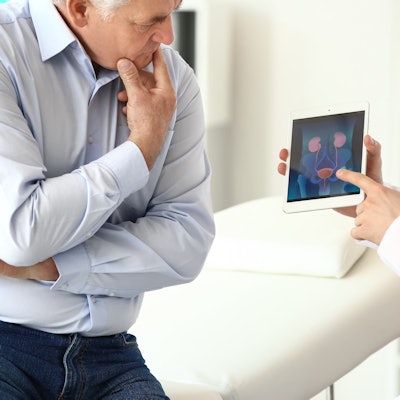
The world has changed pretty dramatically in the past few years. Even before the pandemic, healthcare "consumerism" and value-based care models compelled radiologists to think more critically about their impact on the patient experience. Now, COVID-19 is only adding new patient expectations into the mix.
What was merely an annoyance for patients before the pandemic -- such as waiting in a crowded waiting room before an imaging procedure -- now might provoke outright anxiety. Patients' definition of what makes them "vulnerable" has changed, and they expect clinicians to help reduce those moments of medical vulnerability.
 Paul Shumway. Image courtesy of Novarad.
Paul Shumway. Image courtesy of Novarad.Getting the correct answers fast -- and promptly communicating those answers to the patient and care team -- matters. Patients are no longer willing to feel vulnerable for days and weeks while waiting for scans to drive diagnosis and treatment decisions. They expect the same kind of speed they get from the abundance of information now available online.
To accommodate this expectation, radiologists should consider how they can accelerate diagnoses and treatment decisions by making images and reports more easily and securely accessible through electronic health records (EHRs) or text messages on mobile devices.
Given the pressure to increase satisfaction and quality scores, hospitals and imaging centers must be mindful of such patient perceptions. They should think long-term about how to create a more comfortable patient experience.
Many patients come into a radiology department with injuries or illnesses that already make them feel fearful and vulnerable. Relieving additional fears requires open communication with patients and among all members of the interdisciplinary care team.
Workflows that make it faster and easier for radiologists to collaborate with the rest of the care team may be invisible to patients. Yet, they certainly impact the more visible aspects of patient care, such as wait and turnaround times.
Technology can help align patients' expectations with their experience, but it's not always used with that goal in mind. So, here are a few obvious and unexpected ways radiology teams could leverage technology to create a better patient experience:
- Collaborate through enterprise imaging.
Healthcare organizations that take an enterprise imaging approach can enhance interdisciplinary care collaboration. That's largely due to the ways enterprise imaging facilitates information transparency and supports communication throughout the continuum of care and directly with the patient. One apparent benefit of enterprise imaging is the ability to generate faster and more accurate diagnoses and treatment plans.
Unexpected benefits, however, include the power to use storyboards to better educate and explain care plans to patients. Storyboards show images in the context of the patient's care to help answer the "why?" questions. Enterprise imaging systems can also help bring providers and patients together over mobile images, making patients feel more engaged in their care decisions.
- Utilize innovative applications of patient-friendly technology.
Improvements to the patient experience don't always have to come from brand-new technology. Familiar, patient-friendly technologies such as QR codes, for example, can make the whole imaging process feel more responsive in several unexpected ways.
Radiology departments can securely share images and reports from any DICOM or visible-light image source directly with patients or other providers through QR codes. Consequently, patients can take charge of their own imaging through technology that's more portable, secure, and accessible than carrying CDs from physician to physician.
Indeed, patients may find they need to do less themselves to get the care they need faster. Leaving their radiologist with their images stored on their mobile device is a simple, immediate solution for patients that prevents the "we'll have to wait to find out" perception that has long plagued radiology.
It can also accentuate the experience around joyous reasons for imaging exams -- making it easier to share ultrasound scans of an expected child, for example. For patients who've gotten used to doing everything from viewing restaurant menus to paying bills through QR codes, the technology itself aligns with everyday life.
Many other innovations come from familiar technology as well, from apps that make it possible to securely generate images using personal phones, to video gaming cards that make it possible to quickly render advanced imaging features on radiology workstations.
- Utilize machine learning/artificial intelligence (AI) to provide better, faster procedures.
It's time to forget about AI replacing radiologists and instead lean into its potential to help providers and patients equally. Radiologists should start thinking not about the benefits of man versus machine, but about the benefits of man with machine.
Among their more obvious benefits, machine learning/AI can help improve the patient experience by speeding more precise imaging and interpretation. Consider, however, some additional benefits. With improved speed and accuracy from the collaboration between man and machine, patients may experience shorter wait times between examination and treatment. Furthermore, innovative advancements may create new opportunities for imaging procedures that are less invasive and less time-consuming to perform.
- Align around the patient experience.
Patients expect to schedule scans easily, receive images on their mobile devices, and have necessary imaging information communicated to their care team -- all so they can get an accurate diagnosis quickly. Listening to patients' concerns at every step in the care journey, as well as reducing imaging wait and turnaround times, can significantly reduce patient vulnerability and improve satisfaction.
It's an indisputable fact that hospitals and imaging centers need to provide a better patient care experience while holding the line on costs. Fortunately, these demands aren't at odds and can be facilitated by technology-driven radiology workflows that improve the speed and accuracy of information and communication. Technology can align patients' expectations with their imaging experiences in many unexpected ways.
Paul Shumway is vice president of client services at Novarad, an enterprise imaging vendor.
The comments and observations expressed are those of the author and do not necessarily reflect the opinions of AuntMinnie.com.



















